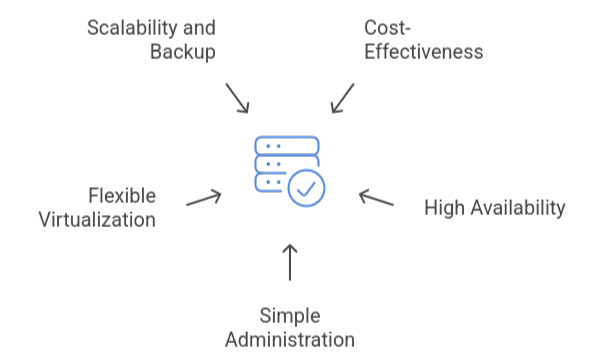Troubleshoot Unstable Proxmox CPU Errors & Kernel Panic with expert tips. Our Proxmox Support team is ready to assist you.
Unstable Proxmox: CPU Errors & Kernel Panics
Proxmox VE is an open-source virtualization platform that lets you run virtual machines and containers on one server. With integrated storage, networking, and high availability technologies, management is made easier. For reliable, adaptable, and effective virtual environments, many companies depend on Proxmox. The main causes of Proxmox VE crashes are covered in this guide, including problems with the CPU, RAM, kernel, and power management. To learn about each problem and how to resolve it successfully, read the article.
What is Proxmox VE?
Proxmox VE is an open-source platform that lets you run virtual machines and containers on a single Debian server. It makes management easy and effective by using LXC for containers and KVM for virtual machines. It helps companies manage virtual environments efficiently and dependably with integrated networking, storage, and high availability technologies.
Proxmox Server Stability Issues
Proxmox servers can sometimes freeze, crash, or run slowly, affecting performance. Checking network configurations, software settings, and hardware is the first step in resolving these problems. CPU errors, malfunctioning storage, out-of-date BIOS or firmware, and incorrect network configurations are common issues. Resolving these issues contributes to the stability and dependability of your Proxmox server.
Follow this expert guide to install Proxmox VE on Raspberry Pi 5 with clear, step-by-step instructions.
Key Benefits of Proxmox VE
Proxmox servers can sometimes freeze, crash, or run slowly, affecting performance.An open-source platform called Proxmox VE uses KVM and LXC to manage virtual machines and containers.
- Cost-effective and free: With optional paid support for updates and help, it does away with licensing fees. NFS, iSCSI, Ceph, and software-defined networking are all supported for effective resource management in flexible storage and networking.
- Elevated Availability: When hardware fails, services continue to function thanks to clustering and HA features.
- Simple Administration: Monitoring, live migration, and virtual machine and container control are made easier via web interfaces.
- Flexible Virtualization: Supports lightweight containers with LXC and entire virtual machines (VMs) with KVM for various workloads.
- Scalability and Backup: Security and growth are ensured by automated backups and simple cluster expansion.
Proxmox VE effectively manages virtual environments by combining dependability, flexibility, and simplicity.

Common Causes of Random Crashes
Random Proxmox VE crashes often occur due to hardware, software, or configuration issues. CPU overheating, malfunctioning or excessively used RAM, storage issues like full disks or failing drives, network driver conflicts, and BIOS power management settings are common factors. Instability can also be caused by virtual machines or containers that use PCI passthrough. Unexpected crashes might also result from incorrectly configured network settings or specific kernel versions.
The problem can be found with the aid of resource allocation reviews, system log checks, and hardware health monitoring. Stability is increased via regular updates, stable drivers, and turning off incompatible BIOS features. Safe troubleshooting and reduced downtime are made possible by making sure backups are made and testing changes progressively.
Overview of Proxmox backup modes in our expert guide for simple, safe backups.
Step 1: Check and Fix CPU Problems
Proxmox VE crashes are frequently caused by CPU problems, particularly following hardware upgrades. Warnings such as these may appear in server logs:
WARNING: CPU: 1 PID: 4122320 at kernel/cgroup/cgroup.c:6685 cgroup_exit+0x166/0x190This suggests possible CPU-related issues, which are frequently connected to new hardware compatibility or process handling.
Solutions:
- Update BIOS: To support new CPU features and address issues, install the most recent BIOS.
- Disable C-states: To avoid instability, disable CPU power-saving settings in the BIOS.
- Check CPU temperature: Verify the CPU’s temperature to prevent overheating and crashes.
Execute Proxmox shutdown commands easily with guidance from our expert guide.
Step 2: Check Kernel Stability
The stability of Proxmox VE can be greatly impacted by kernel versions. There have been reports of random crashes with some of the more recent kernels, such as 6.8. Errors pertaining to hardware interactions or system calls just before a crash may be visible in the logs.
Solutions:
- Downgrade kernel: To increase dependability, go to a stable version, such 6.5.x.
- Monitor logs: Before crashes, check for warnings or panics in the system logs or use dmesg.
- Minimize the number of updates: Steer clear of bleeding-edge kernels unless they are required for a particular feature.
Step 3: Inspect RAM and Memory Usage
Memory problems are a frequent but frequently disregarded reason why Proxmox VE crashes. System instability may result from malfunctioning RAM or excessively allocated memory, particularly when operating several virtual machines and LXCs. High-demand programs or memory leaks can cause crashes even with enough RAM.
Solutions:
- Perform memory tests: To identify defective RAM, use software such as memtest86.
- Review allocations: Ensure combined VM and container memory does not exceed physical RAM.
- Track utilization: To spot high memory usage, use the Proxmox or htop monitoring tools.
Step 4: Adjust Power Management Settings
CPU power-saving techniques like SpeedStep or C-states can occasionally cause server crashes. Instability may result from frequent power status changes, particularly in virtualized setups or with high workloads.
Solutions:
- Disable C-states in BIOS: Prevent the CPU from entering low-power modes that trigger crashes.
- Monitor power states: To verify and modify CPU power settings in the operating system, use tools such as powertop.
Make Proxmox management easier with helper scripts explained in our expert guide.
[Need assistance with a different issue? Our team is available 24/7.]
Conclusion
Addressing Unstable Proxmox: CPU Errors & Kernel Panics is key to maintaining a reliable virtual environment. You can minimize issues, enhance performance, and make sure your Proxmox VE functions properly under all workloads by paying attention to your hardware, memory, kernel versions, and power settings.
In brief, our Support Experts demonstrated how to fix the “554 5.7.1 : Relay access denied” error.







0 Comments